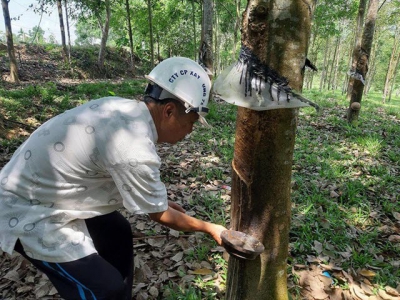Price plunge dashes rubber farmers white gold dream

Tens of thousands of hectares of rubber in Quang Nam province have been abandoned by local farmers who plan to chop down the rubber trees to cultivate other crops.
Complaints about the dramatic rubber price decrease can be heard everywhere these days in Song Tra and Phuoc Tra communes in Hiep Duc district.
One kilogram of fresh latex now can be sold for VND5,000, and dry latex for VND10,000. The revenue from rubber cannot cover labor and fertilizer costs.
Nguyen Phuong Tan in Tra Son hamlet in Song Tra commune was one of the pioneers in growing rubber trees on household-owned land with the support of the district and provincial authorities in 2007-2008.
In 2011, the Quang Nam provincial authorities set up a plan on developing 30,000 hectares of rubber. Most of the land for large-scale rubber farming was allocated to three enterprises, Quang Nam Rubber, Nam Giang Rubber and Vietnam-ROK Investment & Production.
Tan now has 4 hectares of rubber. The investment rate is VND300 million per hectare, not including the land leasing fee and labor cost.
Meanwhile, the rubber latex price has been dropping dramatically over the last three years.
Tan has been advised to chop down rubber trees to grow acacia, but it will require huge capital.
Rubber latex was once considered ‘white gold’ as it promised big money for farmers who sold assets and felled other crops to grow rubber. The total rubber area increased rapidly.
According to Hiep Duc commune People’s Committee, the total rubber growing area in the locality is over 1,000 hectares. In addition, there are also 3,000 hectares of rubber owned by Quang Nam Rubber Company in the locality.
A representative of Quang Nam Rubber said the total rubber area developed by the company had reached 5,900 hectares by the end of 2018. In that year, the company took a loss of VND40 billion.
Truong Thu, director of Quang Nam Rubber, said he has proposed to the Vietnam Rubber Group, the holding company, to allow the planting of large timber forests or other trees in certain positions.
In 2011, the Quang Nam provincial authorities set up a plan on developing 30,000 hectares of rubber. Most of the land for large-scale rubber farming was allocated to three enterprises, Quang Nam Rubber, Nam Giang Rubber and Vietnam-ROK Investment & Production.
In addition, local households also grow rubber on an additional thousands of hectares of land.
Asked about the solutions to the problem, Quang Nam’s deputy chair Le Tri Thanh said provincial authorities plan to cut down the rubber growing area. It is expected that 12,000 hectares of rubber area will be replaced with production forest.
Có thể bạn quan tâm
 Enterprises, cooperatives sign 147 commercial contracts supplying agricultural products
Enterprises, cooperatives sign 147 commercial contracts supplying agricultural products Information from Long An Department of Industry and Trade (DIT), through conferences on connecting supply - demand of goods between Ho Chi Minh City
 Private enterprises as centerpiece for Vietnam’s agricultural development
Private enterprises as centerpiece for Vietnam’s agricultural development Vietnam’s agricultural sector would focus on large scale production and forming agricultural value chains for greater added value, aiming towards sustainable
 Coffee price slides, farmers and merchants incur losses
Coffee price slides, farmers and merchants incur losses The downward trend in coffee prices are affecting farmers and traders. The price hovered around VND48 million per ton at the beginning of 2017 and dropped to VN